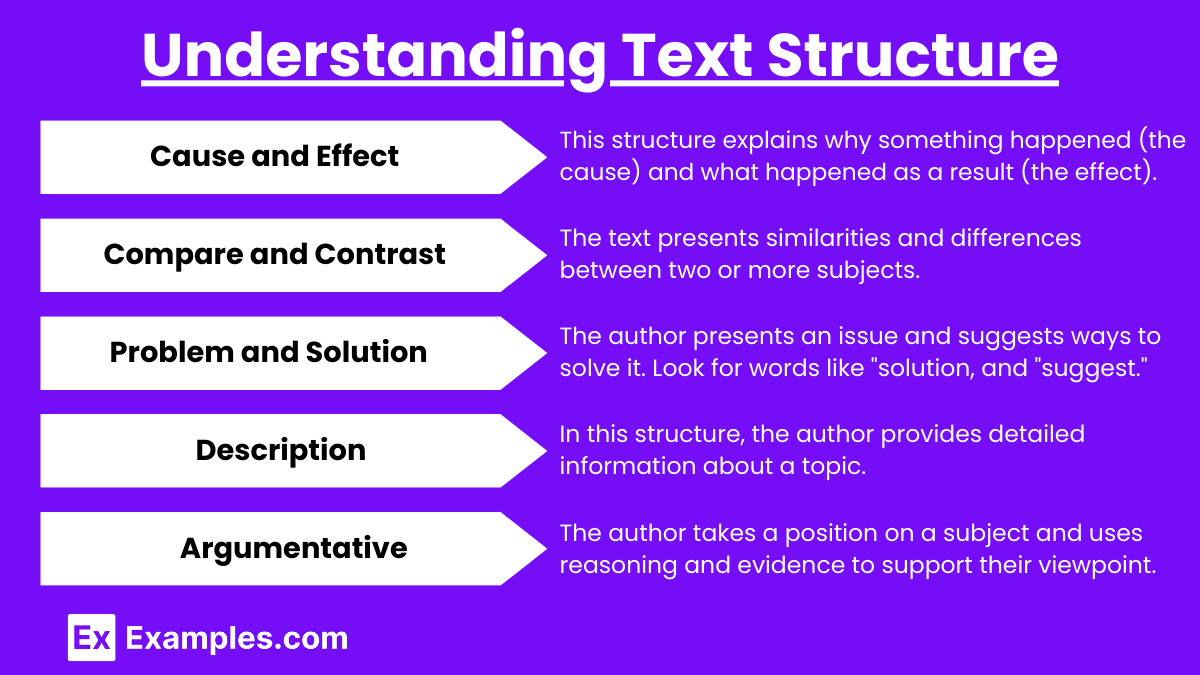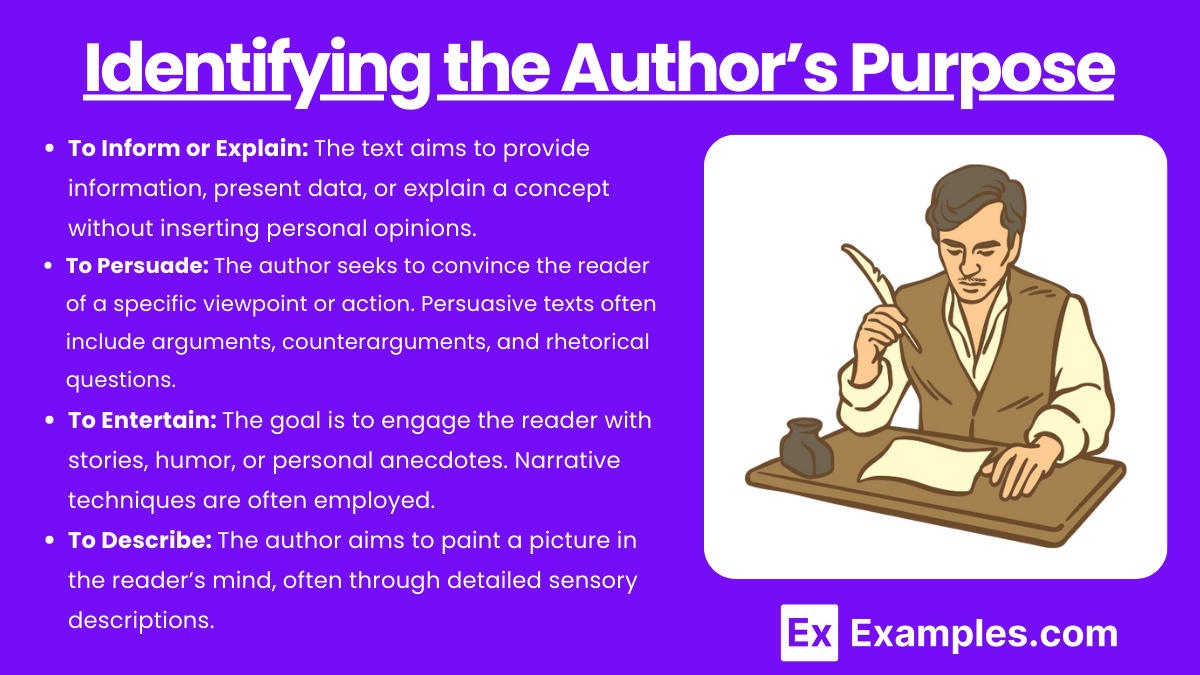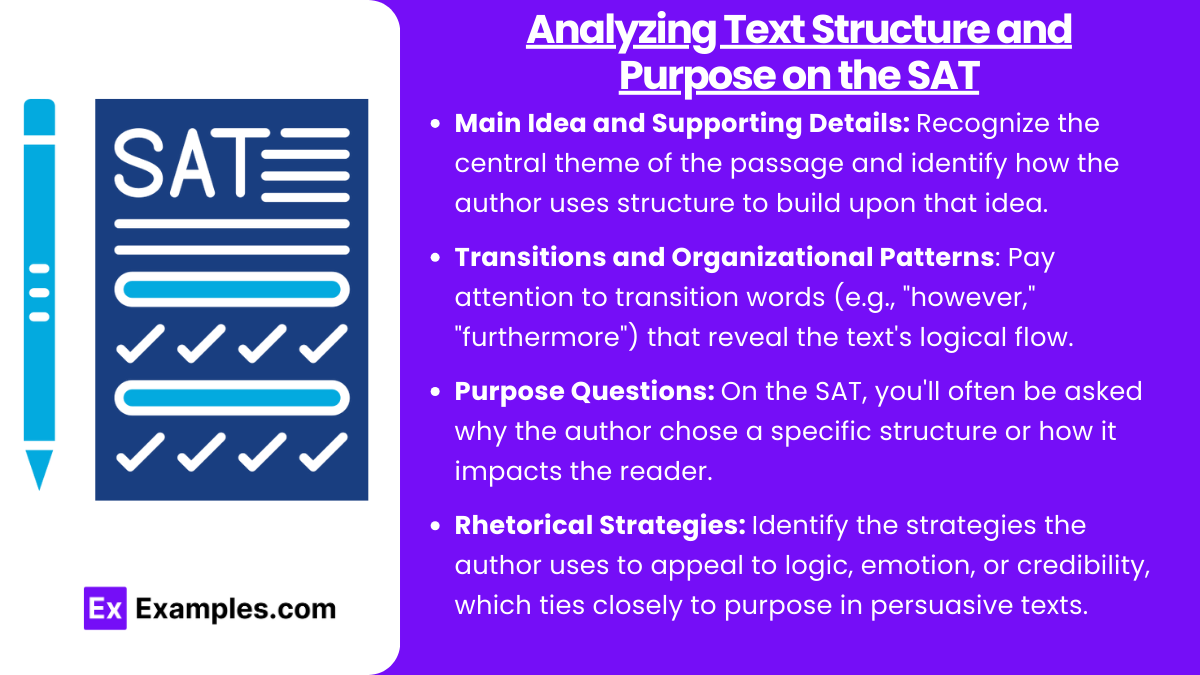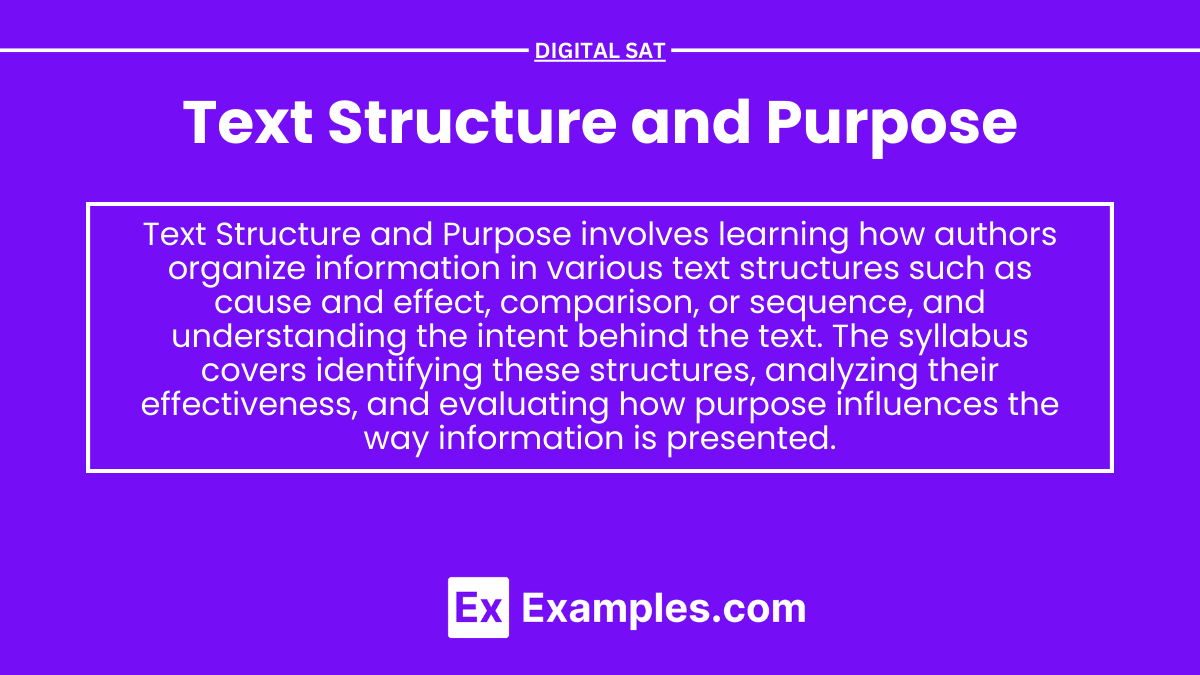Understanding Text Structure and Purpose is essential for excelling in the reading section of the Digital SAT. This concept helps identify how authors organize their ideas (e.g., chronological, compare and contrast) and why they write (e.g., to inform, persuade, or entertain). Mastering this skill enables better comprehension of passages, improving accuracy and speed in answering questions.
Learning Objectives
In studying “Text Structure and Purpose” for the Digital SAT, you should learn to identify how authors organize their ideas using various text structures such as cause and effect, comparison, sequence, and problem-solution. Analyze how the structure supports the author’s main purpose, whether to inform, persuade, or entertain. Evaluate the relationships between different parts of the text and their contribution to the overall meaning. Additionally, develop skills in recognizing how transitions, topic sentences, and paragraph organization guide the reader’s understanding of the text’s purpose and argument.
Understanding Text Structure

- Cause and Effect: This structure explains why something happened (the cause) and what happened as a result (the effect). Look for signal words like “because,” “as a result,” and “therefore.”
- Compare and Contrast: The text presents similarities and differences between two or more subjects. Words like “similarly,” “on the other hand,” and “in contrast” signal this structure.
- Problem and Solution: The author presents an issue and suggests ways to solve it. Look for words like “solution,” “problem,” “resolve,” and “suggest.”
- Description: In this structure, the author provides detailed information about a topic, often through sensory details and adjectives. This can be used in both narrative and expository texts.
- Argumentative: The author takes a position on a subject and uses reasoning and evidence to support their viewpoint. Key signal words include “claim,” “evidence,” and “counterargument.”
Identifying the Author’s Purpose

- To Inform or Explain: The text aims to provide information, present data, or explain a concept without inserting personal opinions.
- To Persuade: The author seeks to convince the reader of a specific viewpoint or action. Persuasive texts often include arguments, counterarguments, and rhetorical questions.
- To Entertain: The goal is to engage the reader with stories, humor, or personal anecdotes. Narrative techniques are often employed.
- To Describe: The author aims to paint a picture in the reader’s mind, often through detailed sensory descriptions.
- To Reflect or Express Feelings: The writer shares personal thoughts, emotions, or reactions, which may appear in reflective essays or memoirs.
Analyzing Text Structure and Purpose on the SAT

- Main Idea and Supporting Details: Recognize the central theme of the passage and identify how the author uses structure to build upon that idea.
- Transitions and Organizational Patterns: Pay attention to transition words (e.g., “however,” “furthermore”) that reveal the text’s logical flow.
- Purpose Questions: On the SAT, you’ll often be asked why the author chose a specific structure or how it impacts the reader. Practice identifying purpose by reviewing different text types.
- Rhetorical Strategies: Identify the strategies the author uses to appeal to logic, emotion, or credibility (logos, pathos, ethos), which ties closely to purpose in persuasive texts.
Examples
Example 1: Chronological/Sequential (Inform)
In a passage describing the development of the Internet, the author begins with the invention of ARPANET in the 1960s, explaining how it laid the foundation for modern networking. The text moves through the timeline of innovations such as the creation of email, the introduction of the World Wide Web, and the rise of social media platforms. The purpose is to inform the reader about the sequence of technological advancements that led to today’s interconnected world.
Example 2: Cause and Effect (Persuade)
In an article discussing climate change, the author explains how the burning of fossil fuels releases greenhouse gases into the atmosphere, causing the planet’s temperature to rise. The passage outlines the resulting effects, such as melting glaciers, rising sea levels, and more frequent natural disasters. The author’s purpose is to persuade the reader that immediate action is necessary to reduce carbon emissions and prevent further environmental damage.
Example 3: Compare and Contrast (Inform)
In a scientific article, the author compares two types of renewable energy sources: solar power and wind power. The passage describes the benefits and limitations of each, such as the cost-effectiveness of solar panels versus the efficiency of wind turbines in certain climates. The purpose of the text is to inform the reader about the differences and similarities between these energy sources to help guide decisions about future energy investments.
Example 4: Problem and Solution (Persuade)
In a passage addressing the issue of food waste, the author begins by highlighting the extent of the problem, noting that millions of tons of food are wasted globally each year. The text then presents potential solutions, such as improving food storage techniques and donating surplus food to charities. The author’s purpose is to persuade governments and organizations to adopt these strategies to reduce food waste and promote sustainability.
Example 5: Description (Entertain)
In a novel, the author vividly describes a tropical rainforest, detailing the dense canopy of leaves, the bright colors of exotic birds, and the constant hum of insects. The passage paints a picture of the lush, vibrant environment through rich sensory details. The purpose is to entertain the reader by immersing them in the beauty and complexity of the natural world, evoking a sense of wonder and appreciation for the rainforest.
Practice Questions
Question 1:
Which text structure is used in the following passage?
“The invention of the printing press by Johannes Gutenberg in the 15th century revolutionized communication. Before this, books were handwritten, making them rare and expensive. Afterward, books could be mass-produced, leading to a rise in literacy rates across Europe.”
A) Compare and Contrast
B) Chronological/Sequential
C) Cause and Effect
D) Problem and Solution
Answer: B) Chronological/Sequential
Explanation:
This passage presents events in a specific time sequence, starting with the invention of the printing press and then explaining what happened before and after it. This type of text structure is known as chronological or sequential because it organizes the information based on the timeline of events.
Question 2:
What is the main purpose of the following passage?
“Recycling is essential for protecting our environment. It reduces the need for raw materials, which in turn minimizes deforestation and habitat destruction. By recycling, we also decrease the amount of waste sent to landfills, reducing the emission of harmful greenhouse gases.”
A) To describe the process of recycling
B) To persuade the reader to recycle
C) To compare different waste management strategies
D) To inform the reader about environmental challenges
Answer: B) To persuade the reader to recycle
Explanation:
The passage is designed to convince the reader of the importance of recycling by outlining its positive effects on the environment, such as reducing deforestation and greenhouse gases. It presents facts and reasoning aimed at persuading the reader to take action by recycling.
Question 3:
What is the primary text structure used in this passage?
“There are several key differences between solar and wind energy. Solar energy relies on the sun’s rays to generate electricity, whereas wind energy uses the motion of the wind. Solar panels are more effective in sunny regions, while wind turbines perform better in areas with consistent, strong winds.”
A) Chronological/Sequential
B) Problem and Solution
C) Cause and Effect
D) Compare and Contrast
Answer: D) Compare and Contrast
Explanation:
The passage highlights the differences between solar and wind energy, comparing how each works and under what conditions they are most effective. This type of text structure is called compare and contrast, as it focuses on the similarities and differences between two or more subjects.


